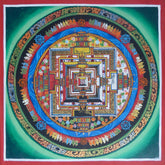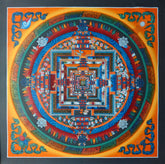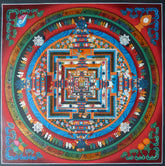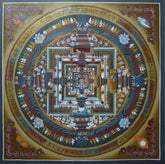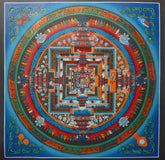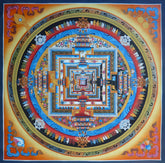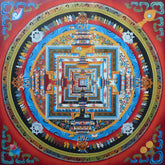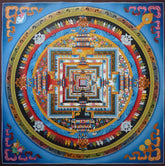Mandalas
 A mandala is s spiritual symbol used in Buddhism and Hinduism to represent the Universe. In their classical forms, they are square with 4 gateways on each side and a central point containing a focus symbol. Each of the 4 doorways contains a different color representing each of the 4 elements;
A mandala is s spiritual symbol used in Buddhism and Hinduism to represent the Universe. In their classical forms, they are square with 4 gateways on each side and a central point containing a focus symbol. Each of the 4 doorways contains a different color representing each of the 4 elements;
- Black doorway represents Earth (mandala must be oriented so that black doorway points downwards)
- Yellow doorway represents Sun
- Blue doorway represents Water
- Red doorway represents Fire
A Mandala is from the artist's view point a birds eye view of a temple seen from above, similar to the picture to the right.
Mandalas are commonly used as a spiritual guidance tool for focusing attention, for establishing a sacred space and as an aid to meditation. The mandala can be considered a simple “diagram” of the basic principles and structures to follow when Meditating. Typically the owner of a thangka mandala painting focuses on the central symbol of the mandala, and for 2 minutes each day they say while focusing "OM MANI PADME HUM" repeatedly (Note that the D in PADMA is silent and is not pronounced). Doing this procedure will bring about positive changes in one's life, including good luck, health and prosperity.
 The Legend Behind the Kalachakra Mandala
The Legend Behind the Kalachakra Mandala
The Kalachakra Mandala, come with an interesting legend or history depending on how you look at it. Involving the historical Buddha, Shakyamuni Buddha, also known as Siddhartha Gautama. Legend has it that King Shuchandra, the king of the mystical Kingdom of Shambala, asked Shakyamuni Buddha for a Tantra or teaching that would allow him practise Dharma without giving up his wordly enjoyments and responsibilities. Much like what we all desire, a way to keep our comforts and remain faithfull to our beliefs and ideals. Buddha then began teaching this to King Shuchandra, who transcribed his teaching into a 60,000 verses that became known as the Kalachakra Tantra. It is upon this Tantra that the Mandala was created.
Sand versus Painting (Thangka)
Mandalas may be made by Buddhists using sand, which are destroyed after they have been made, or they can be painted by Buddhist Llamas onto cotton (thangka painting). In a thangka painting the mandala is oriented so that the dark gateway is at the bottom. It is not uncommon for each mandala to be painted over a period of 6 to 8 weeks.
Even though we only stock mandalas in the form of thangka paintings, the following video shows the Dalai Lama creating and destroying a sand mandala.
Levels of Skill to Creating a Mandala
Mandala paintings may be procured from places such as Katmandu in Nepal, and they are often sold in 3 different levels;
- Mandalas painted by students
- Medium level Mandalas
- Master Level Mandalas
Examples of each level of quality are shown in each of the images below;
|
Student Level |
Medium Level |
|
Master Level |
|
We only stock mandalas here produced by Master Level Llamas in 2 sizes, namely small and large. The large mandalas typically take 6-8 weeks to make.
Audio: Listen to the interview we made with our supplier in Kathmandu, Nepal.
The Kalachakra Mandala
 The Kalachakra Tantra is classified as a Mother Tantra of Anuttaryoga Tantra. TheTranlra is presented in five chapters and it discusses the three Kalachakras, or “bodies” which Buddhists regard as vital to the understanding of life, linking our “being” to the Universe. This very concept that has prompted the Kalachakra Mandala to its current notoriety, offering a simple yet effective way to practice dharma and more importantly compassion.
The Kalachakra Tantra is classified as a Mother Tantra of Anuttaryoga Tantra. TheTranlra is presented in five chapters and it discusses the three Kalachakras, or “bodies” which Buddhists regard as vital to the understanding of life, linking our “being” to the Universe. This very concept that has prompted the Kalachakra Mandala to its current notoriety, offering a simple yet effective way to practice dharma and more importantly compassion.
-
External Kalachakra – This can be considered as the basic sciences : Astrology, Astronomy and Mathematics. It is an external cosmos, the universe and the beings within. It discusses the inter-dependence of the universe and its dependence on the internal cosmos, environmental awareness which is now slowly being understood which was in fact a part of this ancient wisdom.
Our inter-dependence stretches throughout all space and throughout all time. Because of this inter-dependence, the suffering of others is our own suffering, suffering we are ordinarily only able to see and feel for brief moments in others, and as we too feel the pain we so often turn away; but this discovery is in the end the only path leading to the uprooting of the deepest of our sufferings. This is what the young Siddharth, the Buddha to-be, learned when he stepped out of his glittering protected palace.
The cosmology and astrology of the Tibetan Buddhism are also derived from this Tantra.
-
Internal Kalachakra – The structure of the human body and its Energy System which are known as Chakras. The internal cosmos deals with the understanding and totality of nerve centres, life force and energy. Through the proper training and use of these techniques the total personal environment is purified, and the innate Buddha Nature is awakened.
-
Alternative Kalachakra – Deals with the ultimate nature of the cosmos. This deals
with the ultimate truth while the other two are on the level of truth. The alternative Kalachakra also gives us the practices and methods to realize the ultimate truth, which cannot be understood with the mind only, with the wisdom. This wisdom is experienced when the mind ceases.
Since this wisdom cannot be generated with intellectual understanding alone, the method of initiation is employed to enter in the field of the transcendental wisdom. It is a teachings with the combined force of teaching, prayer, blessing, devotion, mantra, yoga and meditation. It is also a permission to practice the Tantra. Even in case one is not in a position of actually practicing the Tantra, a strong Karmic connection is made with the teaching when one receives the initiation. So that the blessings will ripen whenever a right environment can be created.
The above diagram of the Kalachakra Mandala signifies the above mentioned facts. The fingers stretched but within the Mandala is the symbol of the cosmic universe through which the human beings pass after being delivered from the suffering of psychic pain.
5 Level support for Meditation
Each of the 5 levels, or Mandalas if you will, represents a different “initiation” or support for Meditation. Starting from the outermost Mandala and finishing in the lotus centre.
- Mandala of the Enlightened Body
- Mandala of the Enlightened Speech
- Mandala of the Enlightened Mind
- Mandala of Enlightened Wisdom
- Mandala of Great Bliss – Lotus flower centre
The purpose of these 5 Mandalas is to create a visual support for Meditation and what is to be achieved, perhaps even how to achieve it. One may wonder how exactly to penetrate into the Mandala, and therefore begin the slow yet steady journey towards Enlightenment. This information is extremely complex and even I could not allow myself to teach anyone the practice of Kalachakra, scholars and monks spend years if not decades, guided by Gurus (teachers) to gain sufficient siddhis (merits) that allow them to pass from one Mandala to the next. Each step taken towards the centre is considered and achievement.
The 6 elements of the Mandala in our Universe
The 6 elements, may seem a strange concept, as science has it that there are only 4 elements : earth, water, fire, air. Buddhism accepts the existence of 2 other elements: space and wisdom. Although this may seem as strange concept, it is through these 2 elements that a Kalachakra adept is able to meditate on the Kalachakra Tantra.
Note: All of the Mandalas that we stock come unframed in a mailing tube. We recommend when positioning the Mandalas in your home that you do not expose them to direct sunlight for maximum protection.
-
Vendor:Natures Energies
Student Level Kalachakra Mandala - Small Size
Made from naturally occuring materials, including lime, sandstone, and vegetable colors. Note: Images appear brighter on one side due to light source coming from one side when photographed. Dimension (mm) Weight (g) Framed? Including border: 220 x 223 Wide Excluding border: 190 x 190...- $50.00 USD
$59.00 USD- $50.00 USD
- Unit price
- per
-
Vendor:Natures Energies
Master Level Kalachakra Mandala - Medium Size
Made from naturally occuring materials, including lime, sandstone, vegetable colors and 24k gold. Note: Images appear brighter on one side due to light source coming from one side when photographed. Dimension (mm) Weight (g) Framed? Including border: 345 x 350 Wide Excluding border: 295...- $239.00 USD
$250.00 USD- $239.00 USD
- Unit price
- per
-
Vendor:Natures Energies
Master Level Kalachakra Mandala - Medium Size
Made from naturally occuring materials, including lime, sandstone, vegetable colors and 24k gold. Note: Images appear brighter on one side due to light source coming from one side when photographed. Dimension (mm) Weight (g) Framed? Including border: 345 x 350 Wide Excluding border: 295...- $239.00 USD
$250.00 USD- $239.00 USD
- Unit price
- per
-
Vendor:Natures Energies
Master Level Kalachakra Mandala - Medium Size
Made from naturally occuring materials, including lime, sandstone, vegetable colors and 24k gold. Note: Images appear brighter on one side due to light source coming from one side when photographed. Dimension (mm) Weight (g) Framed? Including border: 345 x 350 Wide Excluding border: 295...- $239.00 USD
$250.00 USD- $239.00 USD
- Unit price
- per
-
Vendor:Natures Energies
Master Level Kalachakra Mandala - Medium Size
Made from naturally occuring materials, including lime, sandstone, vegetable colors and 24k gold. Note: Images appear brighter on one side due to light source coming from one side when photographed. Dimension (mm) Weight (g) Framed? Including border: 345 x 350 Wide Excluding border: 295...- $239.00 USD
$250.00 USD- $239.00 USD
- Unit price
- per
-
Vendor:Natures Energies
Master Level Kalachakra Mandala - Large Size
Made from naturally occuring materials, including lime, sandstone, vegetable colors and 24k gold. Note: Images appear brighter on one side due to light source coming from one side when photographed. Dimension (mm) Weight (g) Framed? Including border: 570 x 572 Wide Excluding border: 495...- $560.00 USD
$600.00 USD- $560.00 USD
- Unit price
- per
-
Vendor:Natures Energies
Master Level Kalachakra Mandala - Large Size
Made from naturally occuring materials, including lime, sandstone, vegetable colors and 24k gold. Note: Images appear brighter on one side due to light source coming from one side when photographed. Dimension (mm) Weight (g) Framed? Including border: 570 x 572 Wide Excluding border: 495...- $560.00 USD
$600.00 USD- $560.00 USD
- Unit price
- per
-
Vendor:Natures Energies
Master Level Kalachakra Mandala - Large Size
Made from naturally occuring materials, including lime, sandstone, vegetable colors and 24k gold. Note: Images appear brighter on one side due to light source coming from one side when photographed. Dimension (mm) Weight (g) Framed? Including border: 570 x 572 Wide Excluding border: 495...- $560.00 USD
$600.00 USD- $560.00 USD
- Unit price
- per




